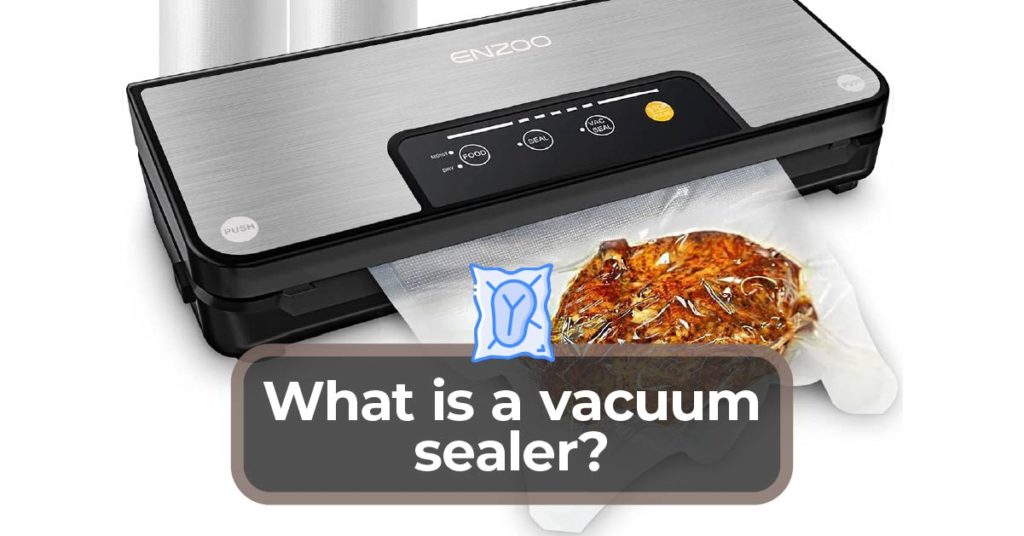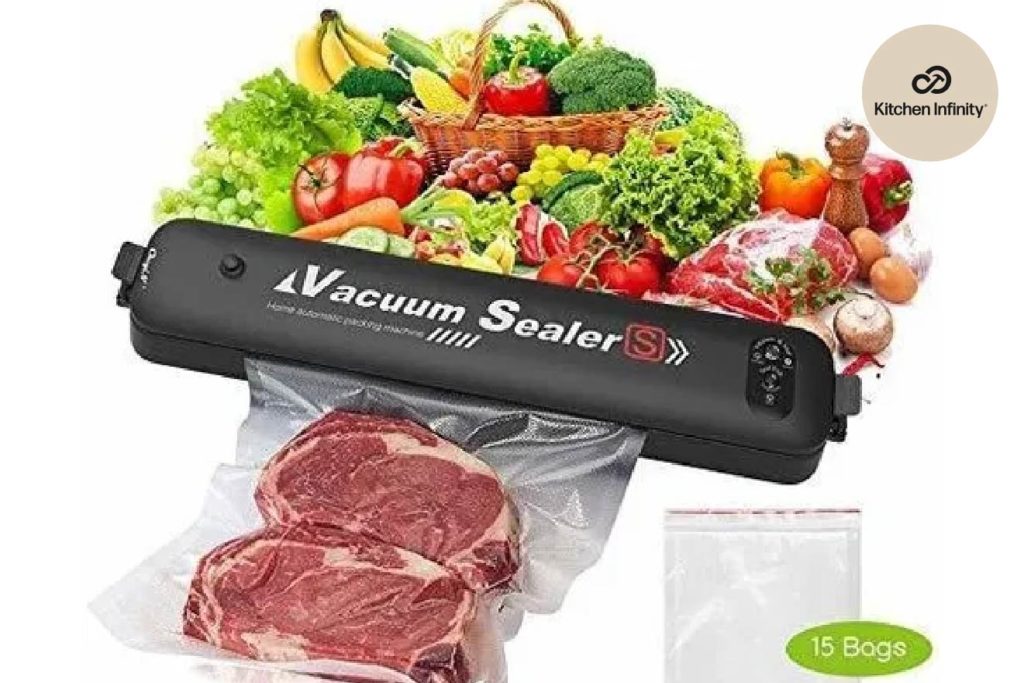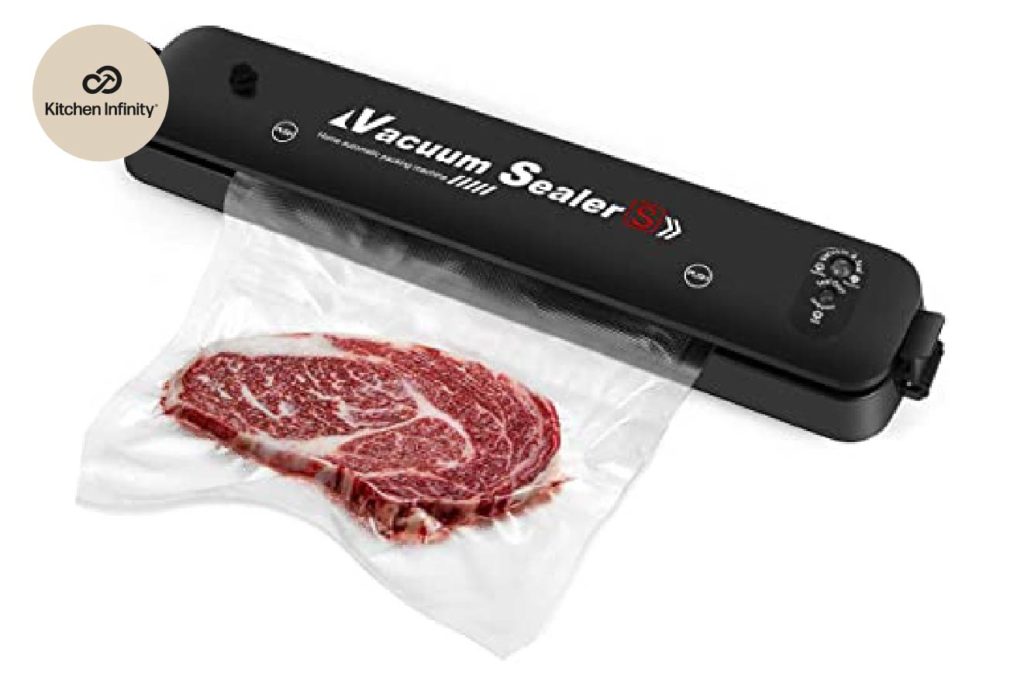
Jump to Section
A vacuum sealer is a kitchen appliance used to seal foods. The primary purpose of a vacuum sealer is to preserve the freshness of foods and prevent them from freezer burn during storage.
The most common type of vacuum sealer is a plastic vacuum sealer. Vacuum sealers come in other materials, including stainless steel. The material determines how long the vacuum sealer lasts and how well it works. Vacuum sealers usually come in a long, flat shape that fits the dimensions of most dishes.
Stainless steel vacuum sealers last longer than other types of vacuum sealers because they’re durable and better designed for frequent use. Stainless steel vacuum sealers cost more than other types, like plastic vacuum sealers, because they don’t have to be replaced as often.
Kitchen vacuum sealers come in different sizes, with the vacuum sealer weight and the vacuum sealer height affecting the size and quantity of ingredients you can preserve.
The history of the vacuum sealer dates back to the 1940s. Initially, the vacuum sealer was invented for commercial purposes.
What is the ideal material for a vacuum sealer?
The ideal material for a vacuum sealer is stainless steel. Stainless steel vacuum sealers are preferred because they are durable and last longer than other types of vacuum sealers, like plastic ones.
Stainless steel vacuum sealers cost more than other types of vacuum sealers. The cheapest type of a vacuum sealer is made with plastic materials but it may not preserve foods as well as a stainless steel vacuum sealer.
People who are concerned about the environment may want to choose a vacuum sealer that is compatible with environmentally friendly bags. Some vacuum seal bags are made with recyclable materials, meaning they have less of an impact on the environment. Most vacuum sealer bags are not biodegradable.
What are the types of vacuum sealers?
The types of vacuum sealers are as follows:
- Handheld vacuum sealer: A handheld vacuum sealer is a small portable vacuum sealer that automatically or manually seals ingredients.
- Manual vacuum sealer: A manual vacuum sealer is a small vacuum sealer that requires manual use with each item.
- Nozzle vacuum sealer: A nozzle vacuum sealer uses an external compressor or nozzle to seal a larger quantity of ingredients.
- Chamber vacuum sealer: A chamber vacuum sealer is an external vacuum sealer that uses embossed pouches to seal ingredients.
What is the ideal size for a vacuum sealer?
The ideal size of a vacuum sealer depends on the size of your household and the number of food items that you seal. Many vacuum sealers are the same size with an average of between 11-12 inches. Vacuum sealers may be slim or tall depending on your preferences. The bag size affects how many items you can vacuum using the vacuum sealer.
What size vacuum sealer do I need? That depends on the needs of your household. One cup of ingredients can fit inside of a 5X7 vacuum bag. A traditional 8 X10 vacuum sealer holds a quart of ingredients. Consider how much food you want to seal at one time and choose a vacuum sealer that accommodates that type of bag. If you have 1-2 people in your household, a smaller, thinner vacuum sealer with smaller bags may be sufficient. If you have 4 or more people in your household, you may want a wider vacuum sealer with larger bags.
What are the use cases of a vacuum sealer?
A use case of a vacuum sealer can be defined as a specific way in which you seal items using one. A few use cases of vacuum sealers include:
- Store and seal bulk meats, like steak or beef.
- Preserve prepped ingredients to use later, like cheeses or sauces.
- Cover wine bottles to keep beverages fresh.
- Reseal snack bags of chips or pretzels.
Once you learn how to use a vacuum sealer, you’ll find it has many uses cases. Vacuum sealers have many storage capabilities beyond that of storing cooked foods.
Can you use a vacuum sealer as a cigar case?
Yes, you can use a vacuum sealer to store cigars. Vacuum sealers remove air from the cigar, so it’s best to store them in the freezer right after sealing them.
Can you use a vacuum sealer as a waterproof camera case?
Yes, because vacuum seal bags are puncture-resistant and moisture-proof, they could technically be used as a waterproof camera case. The vacuum sealer could make it difficult to control your camera’s buttons, so you may want to test this out first.
Can you use a vacuum sealer for storing soup?
Yes, you can use a vacuum sealer for storing soup. Freeze the liquid ingredients first and then move them into a vacuum seal bag to better preserve them.
What are the best vacuum sealer brands?
The best vacuum sealer brands right now are the following:
- Best overall vacuum sealer: FoodSaver
- Best value vacuum sealer: Hamilton Beach
- Best chamber vacuum sealer: Weston Pro
- Best multi-use vacuum sealer: American Harvest

What is the lifespan of a vacuum sealer?
The typical lifespan of a vacuum sealer is 3-5 years. The frequency of use and the types of ingredients you store can affect longevity. Keeping up with routine maintenance and using your vacuum sealer as directed will help it last longer.
The factors that affect the lifespan of a vacuum sealer include:
- Frequency of use: How frequently you use your vacuum sealer, including whether it’s automatic or manual, will affect how fast it wears out. This is because manually sealing ingredients can wear out the lever faster.
- Maintenance and upkeep: If you maintain your vacuum sealer more often then it will last longer. This includes cleaning the vacuum sealer between uses and ensuring foods are frozen before sealing.
- Material selection: The initial quality and material selection affect how long your vacuum sealer lasts. Stainless steel vacuum sealers last longer than plastic vacuum sealers.
- Ingredients used: The type and quantity of ingredients you use most often can affect how long your vacuum sealer lasts. Frequently storing large quantities of liquid ingredients can cause more wear and tear on the vacuum sealer.
The cost of a vacuum sealer ranges from $40-$200. Residential vacuum sealers that require manual use are on the lower end of the range, whereas commercial vacuum sealers with numerous features may cost even more.
How does culture affect the usage of a vacuum sealer?
Vacuum sealers have found their way into most countries around the world. There may be some differences noted in the types of foods most often preserved in different countries using vacuum sealers. Asian countries are most likely to use vacuum sealers for soups and other liquid ingredients, whereas western countries store frozen meats using vacuum sealers.
What are the relevant kitchen tools to a vacuum sealer?
The most relevant kitchen tools connected to a vacuum sealer include:
- Blender: A blender is similar to a vacuum sealer in that both appliances can be used with liquids. A blender is different from a vacuum sealer in that it’s designed to blend liquid ingredients together, whereas a vacuum sealer is used to preserve both liquid and solid ingredients.
- Sous vide cooker: A sous vide cooker is similar to a vacuum sealer in that both appliances are used when prepping ingredients, especially in a commercial setting. A sous vide cooker is different from a vacuum sealer in that it’s meant to heat and serve dishes whereas a vacuum sealer is designed to preserve and store ingredients.
- Refrigerator: A refrigerator is similar to a vacuum sealer in that both appliances can be used to preserve ingredients. A refrigerator is different from a vacuum sealer in that it’s used to chill ingredients, whereas a vacuum sealer seals foods in preparation for storage in the freezer.
- Freezer: A freezer is similar to a vacuum sealer in that both appliances preserve ingredients for a long period of time. A freezer is different from a vacuum sealer in that it holds a large quantity of ingredients whereas a vacuum sealer is usually meant for single-dish preservation.
What is the primary difference between a vacuum sealer and an impulse sealer?
The primary difference between a vacuum sealer vs an impulse sealer is how each appliance seals items. A vacuum sealer seals containers by using a vacuum chamber whereas an impulse sealer uses heat to seal items.
Another difference between a vacuum sealer and an impulse sealer is the types of items that each can seal. A vacuum sealer is primarily used to seal food bags whereas an impulse sealer is used to seal thermoplastic layers including foil or plastic sheeting.
What are the features of a superior vacuum sealer?
Here are eight features of the best vacuum sealers:
- Automatic sealer: An automatic vacuum sealer seals bags without any manual use, making it faster and more efficient.
- Optional handheld sealer: Some fully automatic vacuum sealers also come with an optional handheld sealer which is useful when sealing other items like canisters.
- Removable drip tray: A removable drip tray makes it easier to clean up any liquids after sealing them.
- Seal only: A seal only feature lets you make your own sealable bags from the roll in the unit.
- Included bags: Many vacuum sealer bags come with a variety of different food saving bags for different ingredients.
- Accessory hose: An accessory hose provides an alternative method of sealing your ingredients.
- Retractable hose: A retractable hose can be helpful in having more control over the items you’re sealing.
- Bag detection: Vacuum sealers with automatic bag detection features can automatically recognize your bag in place and begin sealing.
What are the parts of a vacuum sealer?
The parts of a vacuum sealer include the following:
- Seaming head: The seaming head holds the lid and exerts pressure to the rest of the vacuum sealer.
- Seaming roller: The seaming roller connects to the vacuum sealer body to seal the ingredients.
- Vacuum pump: The vacuum pump removes air from the vacuum chamber to create a vacuum.
- Control panel: The control panel is where you activate the vacuum sealer to begin the automated process.
What is the difference between a vacuum sealer and a vacuum?
The primary difference between a vacuum sealer and a vacuum is the purpose of each appliance. A vacuum sealer is designed to securely seal ingredients to preserve them longer whereas a vacuum is designed to suction dirt and debris off the floor.
Another difference between a vacuum sealer and a vacuum is the size and storage of each appliance type. A vacuum sealer can be stored on or under the counter whereas a vacuum is stored in a closet.
How did the vacuum sealer get its name?
The vacuum sealer gets its name from the vacuum-like method it uses to securely seal storage bags. It refers to the method of removing air from the bag which preserves ingredients longer.
You can spell vacuum sealer as: V-a-c-u-u-m s-e-a-l-e-r.
To pronounce vacuum say: (Va-kyoom see-lr).
What is another word for vacuum sealer?
The vacuum sealer may also be referred to as food storage or food saver.

What is the history of the vacuum sealer?
The history of the vacuum sealer dates back to 1940 during World War II. Karl Busch, a German inventor, used it to preserve foods for soldiers going to war. In 1963, the same inventor adapted the vacuum sealer to a larger degree, making it suitable for industrial use. The product has since been adapted to be automatic and is commonplace in households all over the world.


